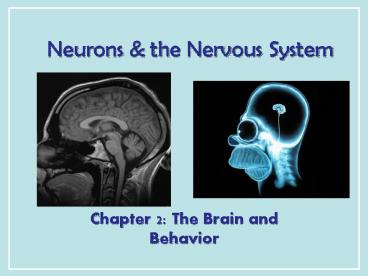Neurons PowerPoint PPT Presentation
1 / 24
Title: Neurons
1
Neurons the Nervous System
- Chapter 2 The Brain and Behavior
2
Todays Goal ? You will be able to.
- Identify the parts of a neuron and their
functions in creating sending neural messages.
3
(No Transcript)
4
Parts of the Neuron
- Neurons nerve cells
- Dendrites branch-like end of neuron which
receives messages - Cell body (soma) contains nucleus
- Axon long tail-like end of neuron which
transmits (sends) messages
5
- Myelin fatty substance that speeds up
transmission of impulse - Axon terminals/Terminal buttons contain
neurotransmitters, release them during neural
impulse - Terminal buttons (axon terminal) bulb-shaped
structure at end of axon
6
Types of Neurons
- Sensory neurons send messages from sensory
receptors to the spinal cord brain - Motor neurons relay messages from brain spinal
cord to muscles glands - Interneurons transmits neural stimulus between
sensory motor neurons (found only in Central
nervous system)
7
Simple Reflex Arc
- Communication goes directly from interneurons in
spinal cord to motor neurons to move
(reflexively) at the same time the info is going
to the brain to be perceived
8
(No Transcript)
9
Central v. Peripheral
- Central contains brain spinal cord
- Peripheral sensory motor neurons that
transmit messages between brain and muscles
glands
10
Autonomic v. Somatic
- Somatic voluntary - controls purposeful body
movements - Autonomic involuntary automatic activities
- heartbeat, respiration, digestion, dilation of
pupils, etc.
11
Sympathetic v. Parasympathetic
- Sympathetic Fight-or-flight response
- Uses energy reserves to cope with stress or
emergency - Adrenaline!
- Parasympathetic Rest and digest
- Conserves builds up stored energy reserves
12
(No Transcript)
13
Todays Goal ? You will be able to.
- Describe how neurons communicate to send messages
in the brain and body
14
The Synapse
- Synapse (synaptic cleft) gap between dendrites
of one neuron and axon of another - Receptor sites parts of dendrite which receive
neurotransmitters - Neurotransmitters chemical substances involved
in sending neural impulses
15
(No Transcript)
16
Neural Impulse electrochemical firing of a nerve
cell
- Resting potential electric potential when neuron
not firing (-70 millivolts) - Threshold level of stimulation required to
trigger a neural impulse (excitatory inhibitory
threshold)
17
Neural Impulse electrochemical firing of a nerve
cell
- Action potential when a neuron fires the impulse
(sends the message) - Refractory period phase after firing an impulse,
neuron will not fire - All-or-none principle neuron will fire or not
fire, no in-between
18
Resting potential
19
Synapses
- Excitatory neurotransmission increases the
likelihood that postsynaptic neuron will fire - Inhibitory neurotransmission decreases
likelihood that postsynaptic neuron will fire
20
Todays Goal ? You will be able to
- Discuss how the major neurotransmitters affect
the body and ones behavior
21
Substances that Affect Neurotransmitters
- Agonist similar to the NT, mimics its effects
- Antagonist inhibits the release of NT by sending
neuron, or blocks receptor site for NT on
receiving neuron
22
Neurotransmitters
- Acetylcholine (ACh)
- EXCITATORY (sometimes inhibitory)
- Memory, muscle contractions, learning
- Malfunctions Alzheimers Disease
23
Neurotransmitters
- Dopamine (DA)
- Reward/pleasure, movement, attention
- Malfunctions Too little ? Parkinsons, Too much
? Schizophrenia - Serotonin
- Mood regulation, sleep and appetite regulation,
concentration, learning - Imbalance ? depression
24
Neurotransmitters
- Norepinephrine
- Involved in autonomic nervous system
(sympathetic) arousal - Imbalances Depression, seizures
- GABA
- Function Reduce anxiety, relax for sleep
- Imbalance Anxiety disorders, tremors, insomnia
- Endorphins ? pain control

